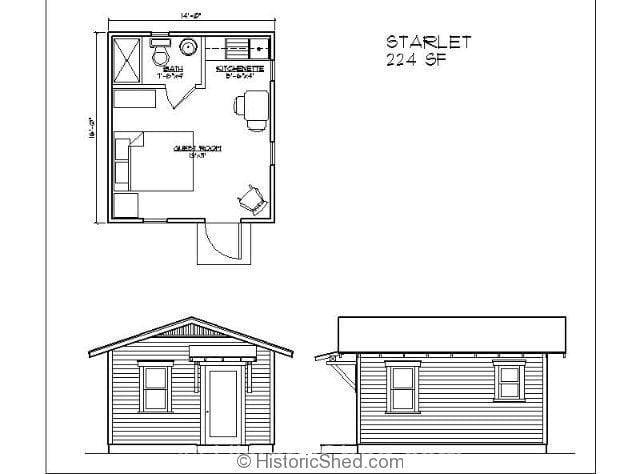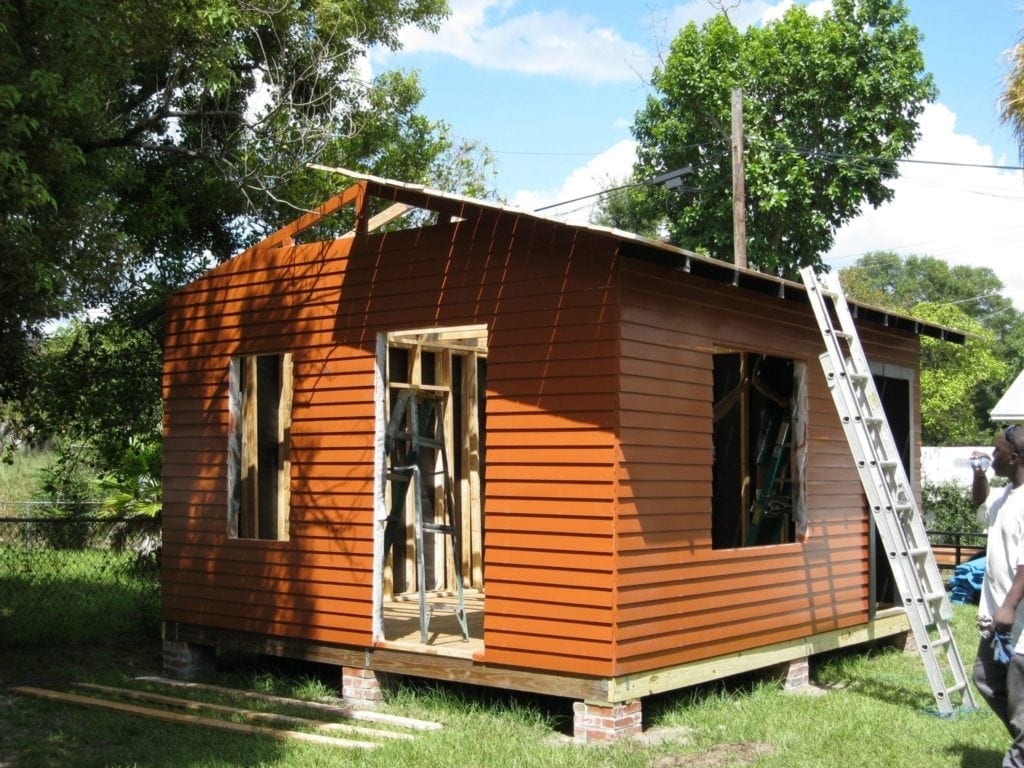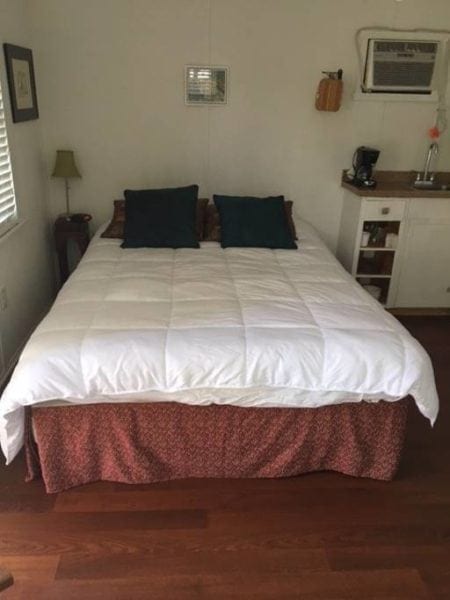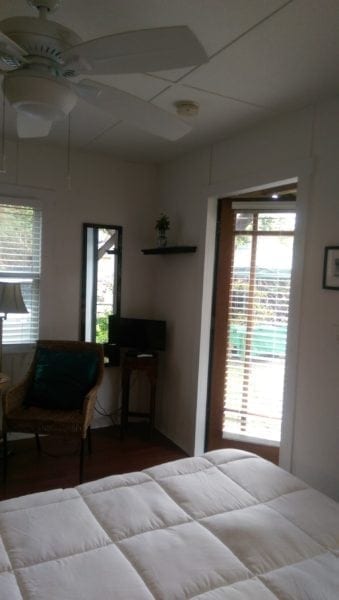Buildings
About
A recent Historic Shed project was designed for the owner to use as a watercolor painting studio. At 10'x10', the shed did not require a building permit in the City of St. Petersburg.

10'x10' gable shed with a finished interior for use as an artists studio.
The studio shed incorporates a door that the owner had saved from the main house many years before. Termites has done extensive damage to the bottom of the door, which we trimmed down and patched.

A salvaged mission style wood door makes a nice focal point on the shed facade.

Salvaged wood windows are located on both sides of the shed to capture cross-breezes.
The interior was finished out with drywall and a tiny wall AC unit will keep the studio comfortable in summer months.


 The shed complements a 1920s bungalow that the owners have lived in for over 30 years.
The shed complements a 1920s bungalow that the owners have lived in for over 30 years.
Historic Shed recently completed this 10'x14' custom garden shed to complement a 1920s residence in the Hyde Park historic neighborhood in Tampa. The storage shed features a gable roof with exposed rafter tails and eave brackets similar to the main house.

The 10'x14' shed replaced a non-historic shed that had fallen into disrepair. Most likely, the spot originally was the location of a one-car garage, not much larger than this new shed.

The shed is simple in design, but rich in details such as the gable end brackets, custom gable louvered vent and cypress bead board double doors.

A pair of 3-lite salvaged wood windows are located on the right side of the shed with cypress flower boxes supported by brackets for a finished look.
My topic at the recent Historic Homes Workshop in St. Petersburg was on choosing exterior paint colors for historic Florida homes (it seemed more fitting to the theme of the workshop than "History of Outbuildings"). Below is the slide presentation that was used as a background for the talk. Unfortunately it doesn't have my witty delivery along with the slides, but I am available to give the presentation to neighborhood associations and other local groups that are interested in the topic. Or you can email for clarification on any of the slide information.
(Click on the four arrows in the lower right corner to see the slides at full size.)
Choosing Exterior Colors for your Historic Florida House
View more presentations from Preservation Resource, Inc./ Historic Shed
Historic homes have plenty of charm and character, but are often short on space. This is especially true when company arrives. Ybor City resident Judy Greer has found an affordable solution to that problem: she is installing a guest cottage behind her home. Designed and built by Historic Shed, a Brooksville-based outbuilding specialty company, the cottage complements her historic home and adds to the neighborhood character. The cottage has a bedroom and full bath, and is roughly the size of a typical hotel room.

Construction of a detached building was a less expensive alternative to building an addition to her home. Moreover, there was no construction inconvenience since all the work took place in her back yard, without disturbing her house. “My guests will be comfortable and I’ll keep my privacy,” say Ms. Greer. “It’s the perfect set-up. My neighbor is considering something similar for her mother-in law.”

The Greer Cottage was an adaptation of the 224 sf Starlet Guest Cottage

Cottage under construction
Historic Shed designs and builds outbuildings for historic homes, from simple garden sheds, to garages, to cottages like Ms. Greer’s. The custom designs incorporate architectural elements from existing historic homes and use traditional materials and detailing. Historic preservation consultant, Jo-Anne Peck and her contractor husband, Craig DeRoin began building Historic Shed outbuildings in 2008 to fill a void in the market for historic homeowners. “Many historic homeowners don’t want a stock metal or vinyl shed in their backyard, and in many cases they are actually prohibited by local historic district design guidelines,” says Ms. Peck. “We also get many calls from owners of newer homes who just want an attractive backyard building.”
Each Historic Shed outbuilding is constructed in a warehouse, broken back down into individual walls and roof for delivery, and then reassembled on site. Installation typically takes 2-3 days for garden sheds and two or more weeks for a more complex structure such as the cottage due to coordination with electrical and plumbing contractors. For more information, see the website at HistoricShed.com.




We have a lot of people in love with our shed designs, but because we use high-end materials, they don't always fit into everyone's budget. So, we've spent some serious time discussing how we can create a more economical design without compromising the charm, detailing and longevity of our product. A shed with faux board and batten siding was one of our design solutions, using pressure treated plywood to simulate the board siding and then applying cypress battens for a finished look. This would reduce both material and labor costs, but when detailed properly, still looks appropriate behind historic homes.
 Board and batten is a traditional historic siding that originated in Norway and Sweden. It was popularized in the United States by Andrew Jackson Downing in the mid 1800s in his picturesque residential designs. The siding was commonly used in Florida for outbuildings, including barns and garages, making it an appropriate material for use on sheds in historic districts. (See a Florida property built in the 1880s with board and batten outbuildings and the shed we built to complement it.)
Board and batten is a traditional historic siding that originated in Norway and Sweden. It was popularized in the United States by Andrew Jackson Downing in the mid 1800s in his picturesque residential designs. The siding was commonly used in Florida for outbuildings, including barns and garages, making it an appropriate material for use on sheds in historic districts. (See a Florida property built in the 1880s with board and batten outbuildings and the shed we built to complement it.)
We'd been discussing building a prototype of the board and batten economy shed for a while, but hadn't managed to find the time. Then we were contacted by a Clearwater couple who wanted an 8'x10' shed that complemented their 1920s bungalow with a stucco exterior. Since they did not need cypress lap siding to match their house, we suggested trying the board and batten shed. They jumped at the chance since the interior of their home features board and batten on their built-in cabinets and as their bath interior finish.

8'x10' Board and Batten Shed
We customized the shed to reflect elements from the main house; we installed a checkerboard gable vent, angle cut the rafter tails, and installed brackets that mimicked the ones on the main house. The end result created a very pleasing shed design that was less expensive to build, yet that maintained historic character and still uses durable materials. We are now pleased to offer the Historic Shed™ Board and Batten Shed line. We think you'll like it.

As attractive as it's useful
While every historic house that we design a shed for is unique, some places have an exceptional story that sets them apart from the rest. This is true of a property settled in the 1880s Florida wilderness where we installed a 12'x14' shed in November that will serve as archives storage. The site is listed on the National Register of Historic Places.
The house is located in what was founded as the the town of Limona in 1876 by Joseph Gillette Knapp, a retired judge from Wisconsin. Knapp actively promoted the area and soon convinced E. E. Pratt of the Illinois-based Elgin Watch Company to settle in Limona and to establish a retirement community for employees. Among the Illinois settlers was a talented watch maker, Charles Scott Moseley, his artist wife Julia Moseley, and their young children. Arriving in 1883, the Moseleys at first moved into a cabin that already existed on the lake-front property, but after a fire in 1885, they built the current house. Designed around a central porch to capture breezes on all sides, the house remains largely unaltered since initial construction. A well, bathhouse, shed and a two-story outbuilding constructed in the 1920s are also located on the site.
 |
| The main house |
 |
| A still-functioning well |
 |
| A storage shed with the bathhouse visible to the right |
 |
| The two-story carport/ studio |
The current owner, a direct descendant of Scott and Julia Moseley, has an extensive collection of letters written by Julia to her husband during his frequent business trips describing life in the Florida wilderness, along with photographs, artwork and other artifacts from early Florida life. The archives shed was designed to store these items in a climate controlled environment as well as provide a work space for visiting scholars. Historic Shed was hired to design and build the shed in a manner that would complement the existing historic site.
Built on tapered concrete piers to match the main house foundation, the shed incorporates cypress board and batten siding, exposed rafter tails, a custom dutch door and gable-end lattice details drawn from the various buildings on the property. Salvaged historic windows for the shed were provided by the owner and still have all their wavy glass panes. The windows are protected by batten shutters which can be fastened during storms to protect the fragile collection. The interior was finished with plywood walls, a pecky cypress ceiling, and cypress flooring. Cypress shelves and a desk constructed out of large cypress planks provided by the owner provide workspace for historians. The shed was insulated with open cell foam and a split mini system air conditioning system provides climate control. The paint scheme was used on the other historic outbuildings originally, using Julia Moseley's favorite colors.
| Wood shake roof |
| Cypress dutch door that mimics one on the main house |
| Batten shutters for storm protection and shading the interior from direct light |
| Salvaged historic wood windows |
| Desk constructed of cypress planks provided by the owner |
| Pecky cypress ceiling with shellac finish |
We design each shed to complement individual historic homes. Our most recent installation was for a storage shed behind an American Foursquare residence with a great wrap around porch.
The American Foursquare is a common house form built from the 1890s through the 1930s. The homes feature a compact plan that fit on suburban lots. Able to have a variety of styles applied, most examples in Florida exhibit Craftsman, Prairie or Mission styling or details. The American Foursquare house type has a roughly square footprint, is typically two or two and a half stories high and has a hipped roof, often with a center dormer. Porches can range from a small portico to wide wrap around porches such as seen on this example. The house layout usually consists of four equal-sized rooms to a floor. The house form was popular due to its efficient layout and economical shape and can be seen in historic districts throughout the United States.
Historic Shed designed a simple storage shed that mimicked the square shape and low sloping hipped roof of the main house. The shed also features wide boxed beadboard eaves and traditional window and door surrounds. Paired carriage house style doors built out of beadboard add an additional degree of historic character.
Last night I was honored to be the guest speaker at the Temple Terrace Preservation Society monthly meeting. Initially developed during the 1920s, Temple Terrace has an impressive collection of Mediterranean Revival style homes and community buildings built during it's initial planning. However, like many 1920s Florida developments, the Depression stopped the realization of the entire planned community, leaving numerous vacant lots ready for building during the next Florida development era that occurred after World War II. During this time, many Mid-century Modern style homes were built in Temple Terrace, including some designed by members of the renowned Sarasota School of Architecture.
Mid-century Modern style is generally defined as a design language with emphases on form rather than ornament, structure and materials rather than picturesque constructions, and the rational and efficient use of space. The Modern movement in architecture in the United States flourished beginning in the 1930s, and embraced technical innovation, experimentation, and rethinking the way humans lived in and used the designed environment. The Sarasota Architectural Foundation describes the implementation of the style in Florida as the following:
While the Sarasota School found its inspiration in part from the philosophies of the Bauhaus, it incorporated forms of regional Southern architecture, using patios, verandas, modular construction and raised floors to open up its buildings for greater ventilation in pre-air-conditioning days. The style added a play of light and shadow, and the color and texture of indigenous low maintenance materials, softening the cold machine aesthetic of the Bauhaus. This approach to design strengthened the connection between architecture and environment, allowing Sarasota School buildings to respect and blend well into their sites. The result was a regional modernism which blurred the distinction between the indoors and outdoors and accommodated the lifestyle and climate of southern Florida.
Homes is this style often have open floors plans, flat roofs with wide cantilevered eaves, and ample rows of windows. Many Mid-century Modern houses utilized then-groundbreaking post and beam architectural design that eliminated bulky support walls in favor of walls seemingly made of glass. In some ways, designing a shed to complement this type of home requires a different mindset than for 1920s homes; however, the basic ideas of complementing the form, proportions, window and door design, and details of the main home as described in previous posts still holds true. You can also find design inspiration in home magazines from this time period, which can be found at garage sales, on e-bay and on-line. For example, the plans for the shed shown above are available on Flickr. The additional pages with links are posted below (click on the image to see it large enough to read). For more design help, please call us at (813) 333-2249 to discuss your Mid-century Modern shed design.